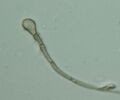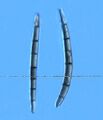Biology:Geoglossum
| Geoglossum | |
|---|---|

| |
| Geoglossum umbratile | |
| Scientific classification | |
| Kingdom: | |
| Division: | |
| Subdivision: | |
| Class: | Geoglossomycetes
|
| Order: | |
| Family: | |
| Genus: | Geoglossum Pers. (1794)
|
| Type species | |
| Geoglossum glabrum Pers. (1794)
| |
| Synonyms[1] | |
| |
Geoglossum is a genus of fungi in the family Geoglossaceae. They are commonly called earth tongues. The type species is Geoglossum glabrum.[2] Geoglossum species are distinguished from the related genus Trichoglossum by the lack of setae on the spore bearing surface. Geoglossum species are characterized by dark, club-shaped, terrestrial ascocarps with a fertile hymenium continuing downward from the apex of the ascocarp along the stipe, eventually intergrading with a sterile stipe. The ascospores of Geoglossum range from translucent to dark brown, and are fusiform, and multiseptate. Identification of species is based on the gross morphology of the ascocarp, color and septation of the ascospores, and shape and ornamentation of the paraphyses.
Taxonomy
Geoglossum was described by Christian Hendrik Persoon in 1794,[3] who created the genus to accommodate Clavaria ophioglossoides L. and three other species: Geoglossum hirsutum (now Trichoglossum hirsutum (Pers.) Boud.), Geoglossum lilacinum (now Thuemenidium atropurpureum (Batsch) Kuntze), and Geoglossum viride (now Microglossum viride (Pers.) Gillet). Persoon expanded the genus in several subsequent publications[4][5][6][7][8] and the name was sanctioned by Elias Magnus Fries in his 1821 Systema Mycologicum I.[9] Several mycologists have treated the genus extensively since Persoon's first work, including George Edward Massee,[10] Elias Judah Durand,[11] Curtis Gates Lloyd,[12] Fred Jay Seaver,[13] and Edwin Butterworth Mains.[14]
Synonyms of Geoglossum include Frigyes Ákos Hazslinszky's Cibalocoryne and Corynetes (both published in 1881), Pier Andrea Saccardo's 1884 Microglossum, and Otto Kuntze's 1891 Thuemenidium.[1] In 1908, Durand circumscribed Gloeoglossum to contain Geoglossum species with paraphyses in a continuous gelatinous layer on the stipe (including G. affine, G. difforme, and G. glutinosum),[11] but the genus is not considered to have independent taxonomic significance.[15]
Modern systematic analysis is sparse, though recent molecular studies have supported Geoglossum as monophyletic.[16][17]
Description
The fruit bodies of Geoglossum species are usually club-shaped, with a surface that is dry to sticky or gelatinous (particular in wet weather), and brown to black. The hymenium (spore-bearing surface) is confined to the upper club-shaped part of the fruit body. Stipes are slender and cylindrical, with a surface texture ranging from smooth to squamulose (covered with tiny scales), or, in some instances, covered with tufts of tiny hairs. The asci are club-shaped, inoperculate (without a cap or lid), and usually contain eight ascospores. These spores are club-shaped to somewhat cylindrical to somewhat fusiform. Brown to hyaline in color, there are both septate and non-septate forms (or, in some species, a combination of the two). There are paraphyses mixed with the asci, and in some species these occur on the stipes scattered or grouped together so as to form small tufts or scales. In some species they are spread out on the stipe surface as a continuous gelatinous layer.[14]
Distribution
Geoglossum species are found worldwide and have been studied extensively in Asia,[18][19] Australasia,[20] Europe,[10][21] India,[22] North America,[11][14] and South America.[23]
Selected species
Index Fungorum currently lists 160 names of Geoglossum, including forms and varieties, though many dubious, invalid names and synonyms have been published in the genus to date. The Dictionary of the Fungi (10th edition, 2008) recognizes 22 species.[24] However, a number of new combinations and novel species have been proposed since, based on molecular and morphological data.[25][26][27]
Conservation
Several species of Geoglossum are considered to be of conservation significance and many species are found on Regional Red Lists of several European countries. Geoglossum are common components of the endangered waxcap grassland habitat in Europe. G. arenarium is listed as vulnerable in Estonia[28] G. atropurpureum is a UK Biodiversity Action Plan Priority species,[29] and is listed as critically endangered in Denmark [30] and Estonia.[28] G. atrovirens is listed as critically endangered in Estonia.[28] G. cookeanum is listed as endangered in Switzerland.[31] G. difforme is listed as critically endangered in Denmark[32] and endangered in Sweden.[33] G. glabrum is listed as critical in Czech Republic.[34] G. hakelieri is listed as vulnerable in Sweden.[33] G. littorale is listed as critically endangered in Denmark,[35] and endangered in Sweden.[33] G. sphagnophilum is listed as endangered in Denmark.[36] G. starbaeckii is listed as vulnerable in Denmark.[37] G. uliginosum is listed as critically endangered in Sweden.[33] G. umbratile is listed as critically endangered in Bulgaria.[38]
References
- ↑ 1.0 1.1 "Synonyms: Geoglossum Pers., Neues Mag. Bot. 1: 116 (1794)". Index Fungorum. CAN International. http://www.speciesfungorum.org/Names/SynSpecies.asp?RecordID=2049.
- ↑ "Index Fungorum - Geoglossum Genus". http://indexfungorum.org/Names/NamesRecord.asp?RecordID=2049.
- ↑ Persoon CH. (1794). "Neuer Versuch einer systematischen Eintheilung der Schwämme". Roemer's Neues Magazin für die Botanik 1: 63–128.
- ↑ Persoon CH. (1796). Observationes Mycologicae 1. Leipzig: Gesnerus, Usterius & Wolfius.
- ↑ Persoon CH. (1797). Commentatio de Fungis Clavaeformibus. Leipzig: Petrum, Phillipum & Wolf.
- ↑ Persoon CH. (1799). Observationes Mycologicae 2. Leipzig: Gesnerus, Usterius & Wolfius.
- ↑ Persoon CH. (1801). Synopsis Methodica Fungorum 2. Göttingen: Henricus Dieterich.
- ↑ Persoon CH. (1822). Mycologia Europaea 1. Erlangen: JJ Palmius.
- ↑ Fries E.. Systema Mycologicum I. Lundin: Sumtibus Ernesti Mauritti.
- ↑ 10.0 10.1 Massee G. (1897). "A monograph of the Geoglossaceae". Annals of Botany 11: 225–306. https://archive.org/stream/annalsbotany04progoog#page/n277/mode/2up.
- ↑ 11.0 11.1 11.2 Durand EJ. (1908). "The Geoglossaceae of North America". Annales Mycologici 6 (5): 387–477. http://www.cybertruffle.org.uk/cyberliber/59685/0006/005/0387.htm.
- ↑ Lloyd CG. (1916). "The Geoglossaceae". Mycological Writings 5.
- ↑ Seaver FJ. (1951). The North American Cup-Fungi (Inoperculates). New York: Hafner.
- ↑ 14.0 14.1 14.2 Mains EB. (1954). "North American species of Geoglossum and Trichoglossum". Mycologia 46 (5): 586–631. http://www.cybertruffle.org.uk/cyberliber/59350/0046/005/0586.htm.
- ↑ "Gloeoglossum E.J. Durand, Annales Mycologici, 6: 418, 1908". MycoBank. International Mycological Association. http://www.mycobank.org/BioloMICS.aspx?Table=Mycobank&Rec=100671&Fields=All.
- ↑ Sandnes ACS. (2006). Phylogenetic relationships among species and genera of Geoglossaceae (Helotiales) based on ITS and LSU nrDNA sequences (Cand. Scient. thesis). The University of Oslo, Norway.
- ↑ "Inclusion of Nothomitra in Geoglossomycetes". Mycosphere 2: 646–654. 2011. doi:10.5943/mycosphere/2/6/5. http://wwx.inhs.illinois.edu/files/4413/4281/8865/Nothomitra_Hustad_et_al_Mycosphere2011.pdf.
- ↑ Imai S. (1941). "Geoglossaceae Japoniae". Journal of the Faculty of Agriculture, Hokkaido Imperial University 45 (4): 155–264. http://eprints.lib.hokudai.ac.jp/dspace/bitstream/2115/12738/1/45%284%29_p155-264.pdf.
- ↑ Tai FL. (1944). "Studies in the Geoglossaceae of Yunnan". Lloydia 7: 146–162.
- ↑ Spooner BM. (1987). "Helotiales of Australasia: Geoglossaceae, Orbiliaceae, Sclerotiniaceae, Hyaloscyphaceae". Bibliotheca Mycologica 116: 1–711.
- ↑ Nannfeldt JA. (1942). "The Geoglossaceae of Sweden". Arkiv för Botanik 30A: 1–67.
- ↑ Maas Geesteranus RA. (1965). "Geoglossaceae of India and Adjacent Countries". Persoonia 4 (1): 19–46. http://www.cybertruffle.org.uk/cyberliber/61056/0004/001/0019.htm.
- ↑ "La familia Geoglossaceae s. str. (Helotiales) en la provincia de Tucumán (Argentina)" (in es). Boletín de la Sociedad Argentina de Botánica 44 (3–4): 249–255. 2009. http://www.scielo.org.ar/scielo.php?script=sci_arttext&pid=S1851-23722009000200003.
- ↑ Dictionary of the Fungi (10th ed.). Wallingford: CAB International. 2008.
- ↑ "Generic circumscriptions in Geoglossomycetes". Persoonia 31: 101–111. 2013. doi:10.3767/003158513X671235. PMID 24761038.
- ↑ Arauzo S., Iglesias P. (2014). "La familia Geoglossaceae ss. str. en la península ibérica y la Macaronesia". Errotari 11: 166–259.
- ↑ Loizides M., Carbone M., Alvarado P. (2015). "Geoglossum dunense (Ascomycota, Geoglossales): a new species from the Mediterranean islands of Cyprus and Malta". Mycological Progress 14 (6): 41. doi:10.1007/s11557-015-1064-9.
- ↑ 28.0 28.1 28.2 Parmasto E. (July 2009). "Red Data List of Estonian Fungi 2008". Mycology group of the Estonian Commission for Nature Protection at the Estonian Academy of Science. http://www.wsl.ch/eccf/Estonia09.pdf.
- ↑ "UK BAP Priority Fungal Species". http://jncc.defra.gov.uk/page-5165.
- ↑ "Danish Red List". http://www.neri.dk/1_Om_DMU/2_Tvaer-funk/3_fdc_bio/projekter/redlist/data_en.asp?ID=5211&gruppeID=93.
- ↑ (in fr) Liste Rouge des Champignons Supériors Menacés en Suisse. L'environnement pratique no 0718 (Report). Office fédéral de l'environnement, Berne, ((et WSL)), Birmensdorf, Switzerland. 2007.
- ↑ "Danish Red List". http://www.neri.dk/1_Om_DMU/2_Tvaer-funk/3_fdc_bio/projekter/redlist/data_en.asp?ID=5209&gruppeID=93.
- ↑ 33.0 33.1 33.2 33.3 "Swedish Red List". http://www.wsl.ch/eccf/Swedish-fungal-Red-List_2010.xls.
- ↑ "Červený seznam hub (makromycetů) České republiky" (in cs). Agentura ochrany přírody a krajiny ČR (AOPKČR)/Agency for Nature Conservation and Landscape Protection of the Czech Republic. 2006. http://www.wsl.ch/eccf/Czech07.pdf.
- ↑ Vesterholt J. "Geoglossum littorale (Rostr.) Nannf.". The Danish Red Data Book. Danmarks Miljøundersøgelser. http://www.neri.dk/1_Om_DMU/2_Tvaer-funk/3_fdc_bio/projekter/redlist/data_en.asp?ID=5206&gruppeID=93.
- ↑ "Danish Red List". http://www.neri.dk/1_Om_DMU/2_Tvaer-funk/3_fdc_bio/projekter/redlist/data_en.asp?ID=5204&gruppeID=93.
- ↑ "Danish Red List". http://www.neri.dk/1_Om_DMU/2_Tvaer-funk/3_fdc_bio/projekter/redlist/data_en.asp?ID=5203&gruppeID=93.
- ↑ "Red List of fungi in Bulgaria". Mycologia Balcanica 3: 81–87. 2006. https://www.scribd.com/doc/38221994/Red-List-of-fungi-in-Bulgaria.
External links
- Geoglossum photos at Mushroom Observer
Wikidata ☰ Q3101202 entry
ca:Geoglossaceae
 |





